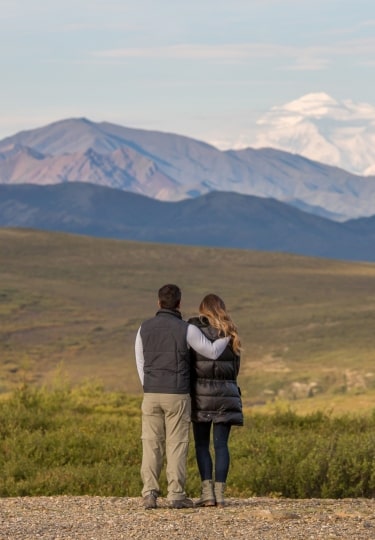Alaska in September is simply wonderful. As the summer segues into fall, Alaska is transformed. The tundra erupts in a blaze of colors, from ocher to scarlet and burnt orange. The vast Tongass Forest takes on its dazzling autumnal hues.
Animals begin to prepare for the winter, fattening up on berries and late-season salmon. The first snowfall dusts the mountains and, in the north, the aurora borealis dances across the night sky.
Whether you’re interested in culture and history or are here for the wildlife and spectacular scenery, here are some of the many reasons to take a September trip to the Last Frontier.
Snow on the Mountains
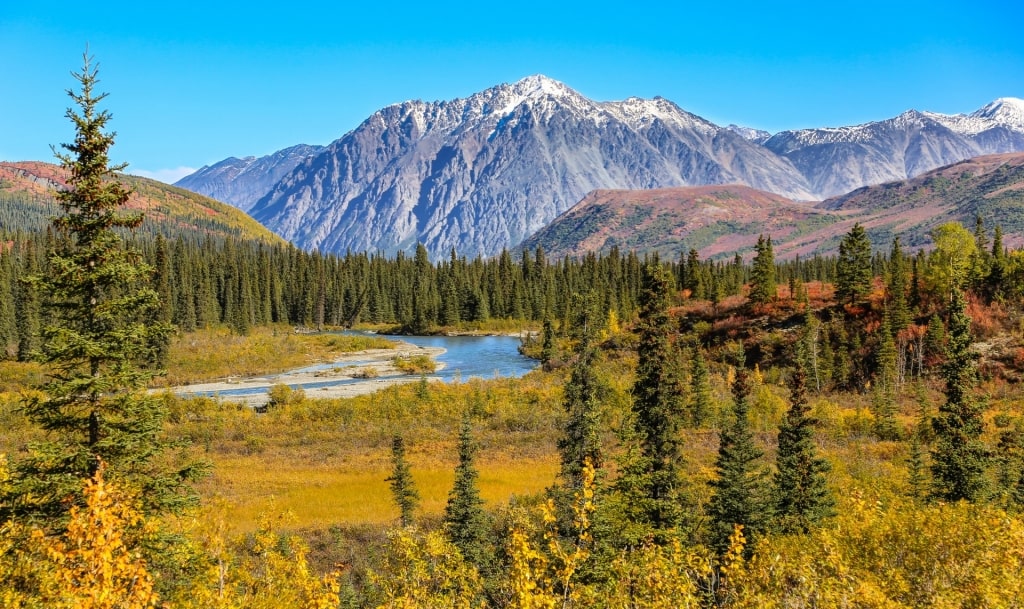
Denali National Park
The first snow, known locally as “termination dust”, falls on the mountains at some point in September, creating the picturesque views that Alaska is known for.
The phrase was made up by early gold miners, as it means the end of summer and the approach of the harsh winter—and those gold prospectors didn’t stop just because the weather was getting cold.
Photographers will love the mesmerizing sight of the first snowfall, especially on a clear day. The white mountaintops scrape a deep blue sky, while the orange and yellow fall foliage on the lower slopes creates the perfect contrast. Fall really is one of the best times to visit Alaska.
The Aurora in the Sky
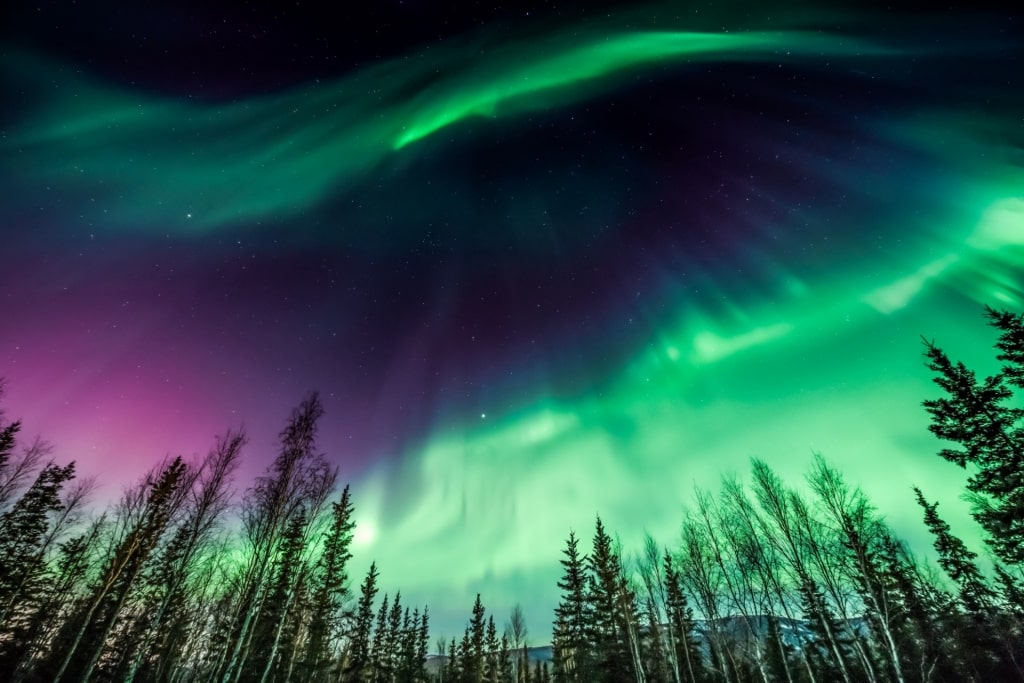
Aurora
As the days get shorter, particularly in the north of Alaska, your chances of spotting the aurora borealis increase. Just head outdoors any time after 10 pm and you could get lucky.
Sometimes, the aurora presents itself as shimmering white patterns across the sky that dissolve and reform. Other times, you’ll see the full rippling curtains effect, with pinks and greens creating a magnificent light show.
The best place to see the aurora in September is around the beautiful town of Fairbanks, away from the city lights, although it’s possible anywhere north where it’s dark.
Flaming Fall Colors
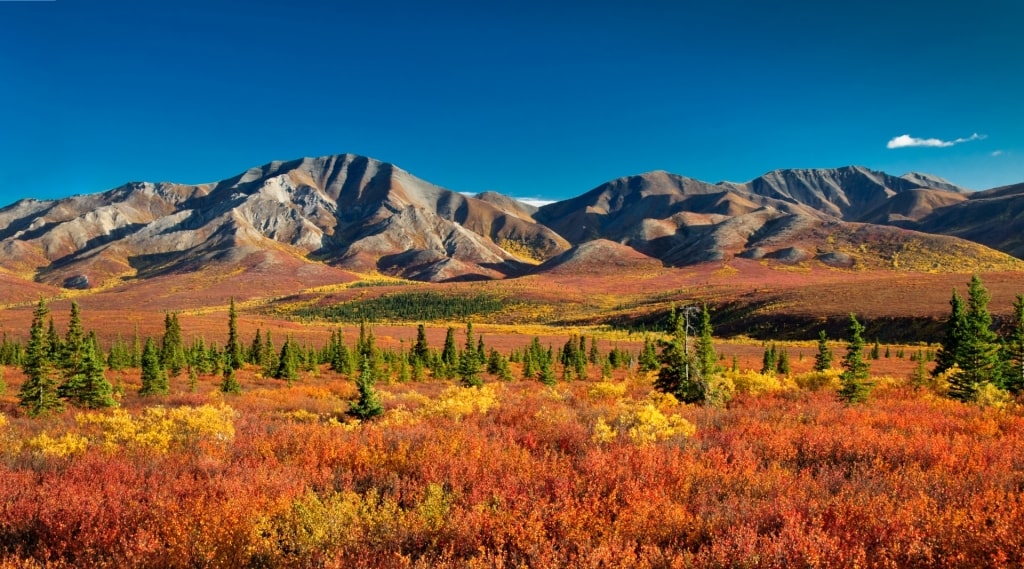
Denali National Park
Alaska’s fall colors manifest themselves earlier than in other states, and you should get a good display from early September onwards.
The aspens take on a brilliant yellow, while willow trees turn orange. Across the tundra, especially vivid in Denali National Park—one of the best national parks in Alaska—nature throws in deep crimson, too.
All this beauty is best admired from above. Experience flightseeing in Alaska on a tour over Denali National Park and you’ll see the fall colors of the tundra in their full glory.
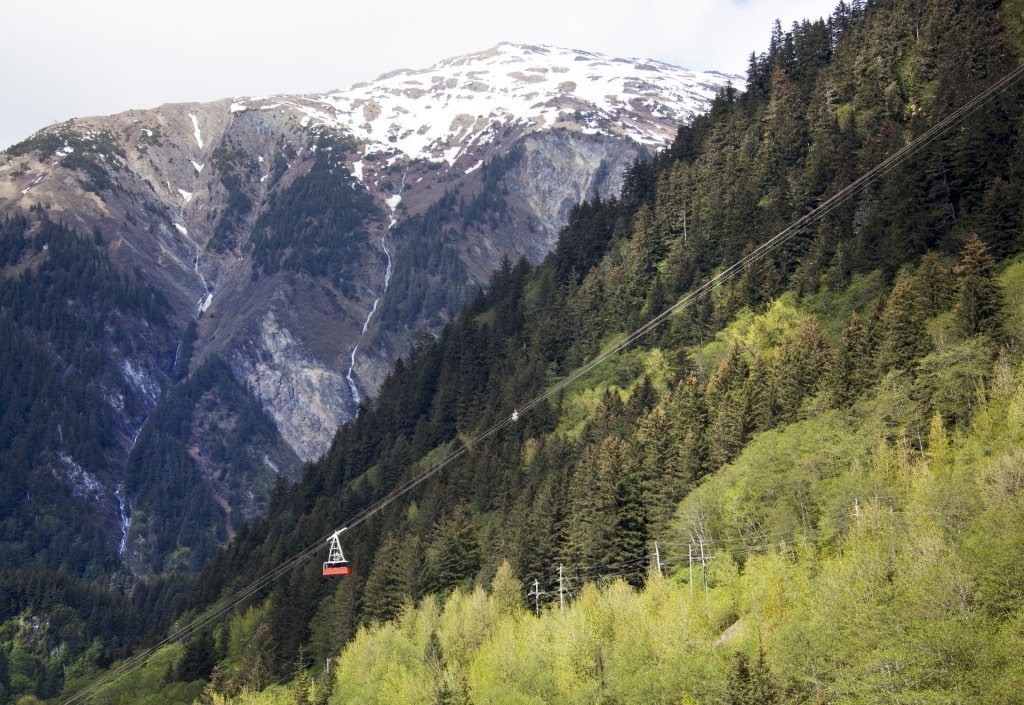
Mount Roberts Tramway, Juneau
Or head up the Mount Roberts Tramway from Juneau and look down on the vast expanse of the Tongass Forest, stretching away beneath you. From Ketchikan, join a zipline adventure, flying down the mountainside over the tips of hemlock, spruce, and cedar trees.
Read: Best Spots for Ziplining in Alaska
Whale & Dolphin Sightings
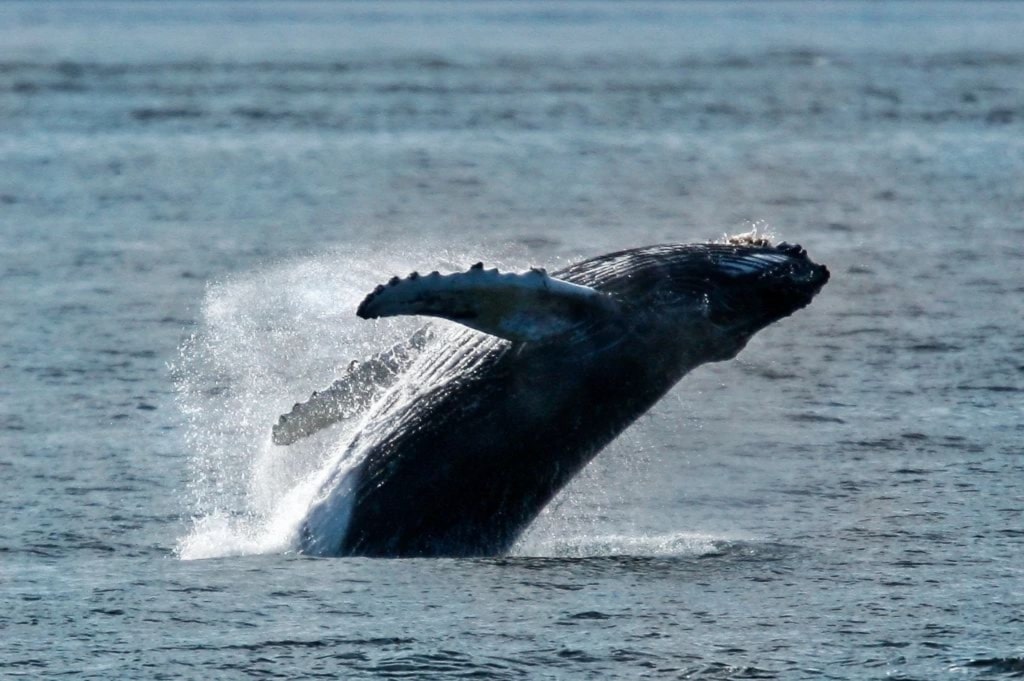
Humpback whale
Some of the whale species that visit Alaska are migratory and begin to head south as summer fades to fall.
However, you’ll still stand an excellent chance of spotting dolphins, which are here year-round, and resident pods of orca, especially as you explore the forested Inside Passage. Humpback whales stay around Alaska’s waters until November.
Juneau is one of the best places in Alaska to go whale-watching. You’ll set out on a small boat from Auke Bay to the deep trenches where the whales feed.
Guides will point out whale behavior, from “bubble net” feeding to tail-slapping, and if you’re lucky, breaching, when the whale leaps right out of the water.
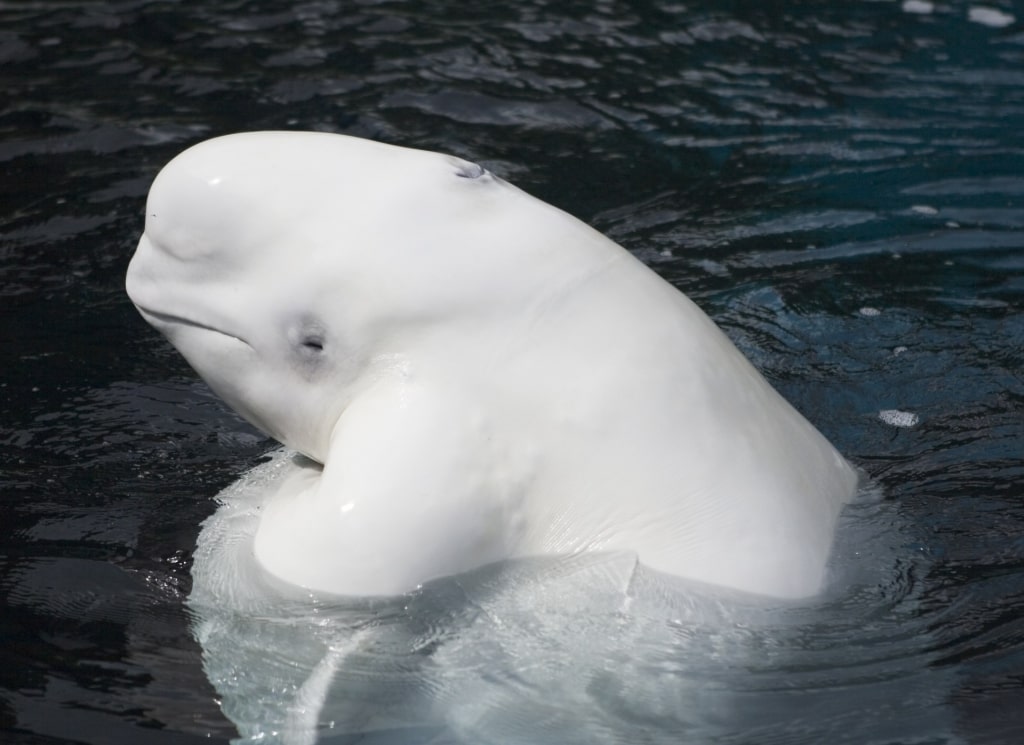
Beluga whale
Further north, you may even be lucky enough to spot graceful white beluga whales. The best place to see them is the appropriately named Beluga Point, on the road from Seward to Anchorage.
Read: Must-Do Experiences in Alaska
Plenty of Daylight
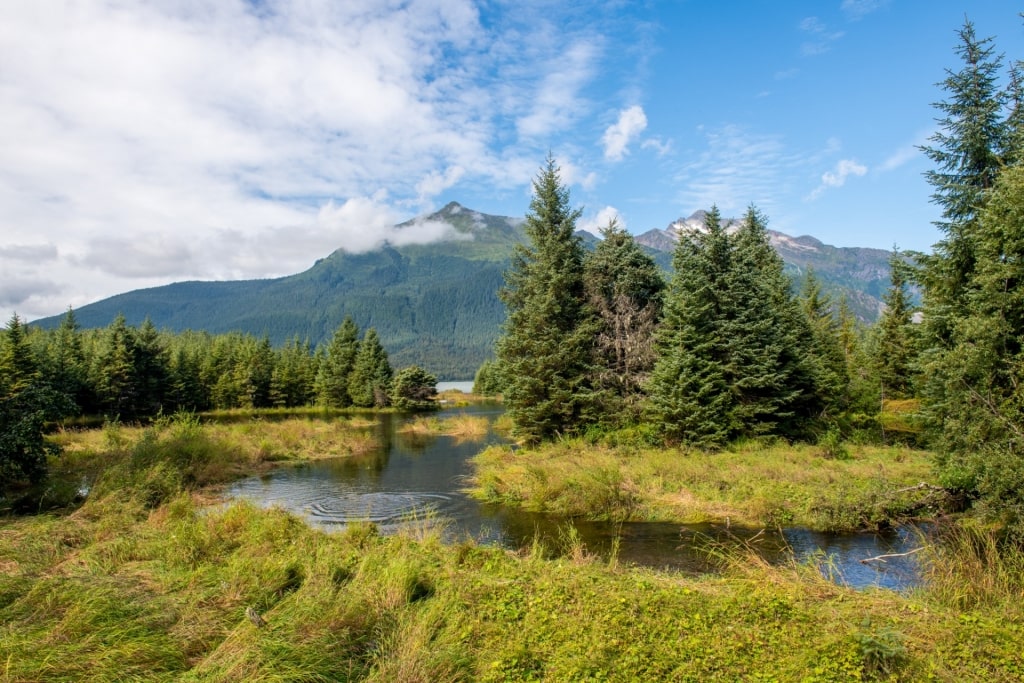
Mendenhall Glacier Visitor Center, near Juneau
While it’s true that Alaska receives extremes in daylight—barely any in the middle of winter and 18 hours or more in midsummer—you’ll be just fine in September. Juneau, for example, receives 12 to 13 hours of daylight in September, which is plenty for enjoying the great outdoors.
What you may notice, especially if you’ve been to Alaska before in midsummer, is shorter evenings, with sunset between 7 pm and 8 pm. So there’s still plenty of time to look for the blow of a whale breaking the still water as the light fades, or to spot Alaskan birds flying home to roost for the night.
Animals Fattening up for Winter
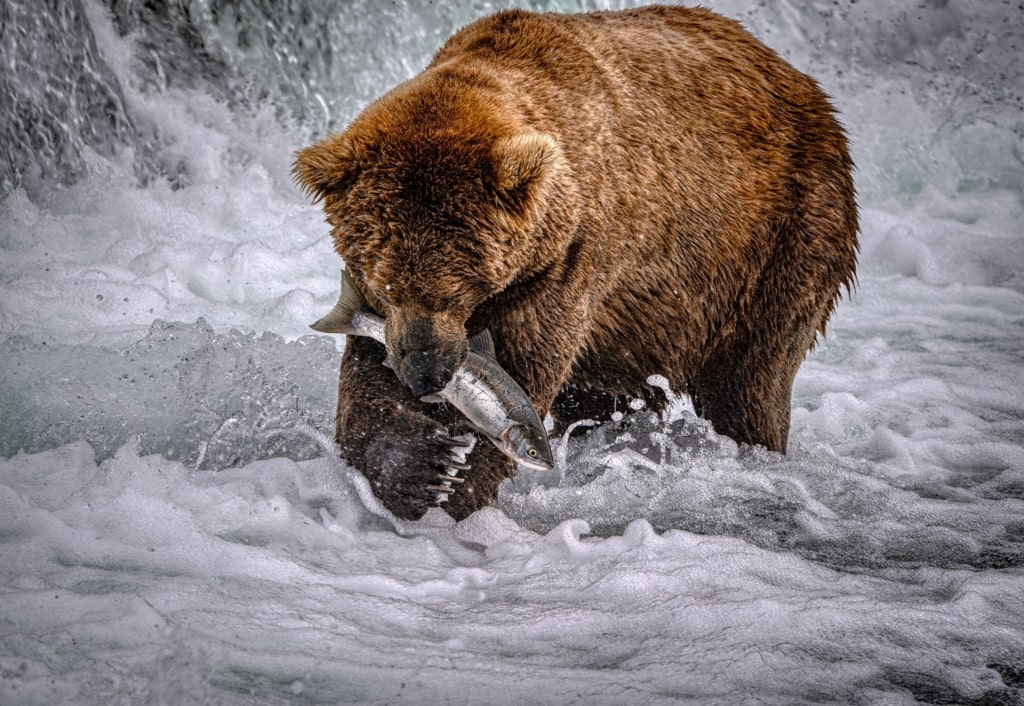
Bear
Alaska is, of course, frozen and snowbound in winter, so fall is the time for large mammals to fatten up as much as they can for the lean months ahead. As such, you’ll see caribou and moose gorging themselves, and bears feasting on late salmon and juicy berries.
Aside from being one of the most beautiful places in Alaska, Denali National Park is the best place to look for the “Big Five”, especially in September, when you could see moose, caribou, Dall sheep, wolves, and grizzly bears.
You also stand a good chance of spotting other popular Alaskan animals such as coyotes, red fox, lynx, wolverines, marmots, and otters on your Denali adventure.
Late Salmon Runs
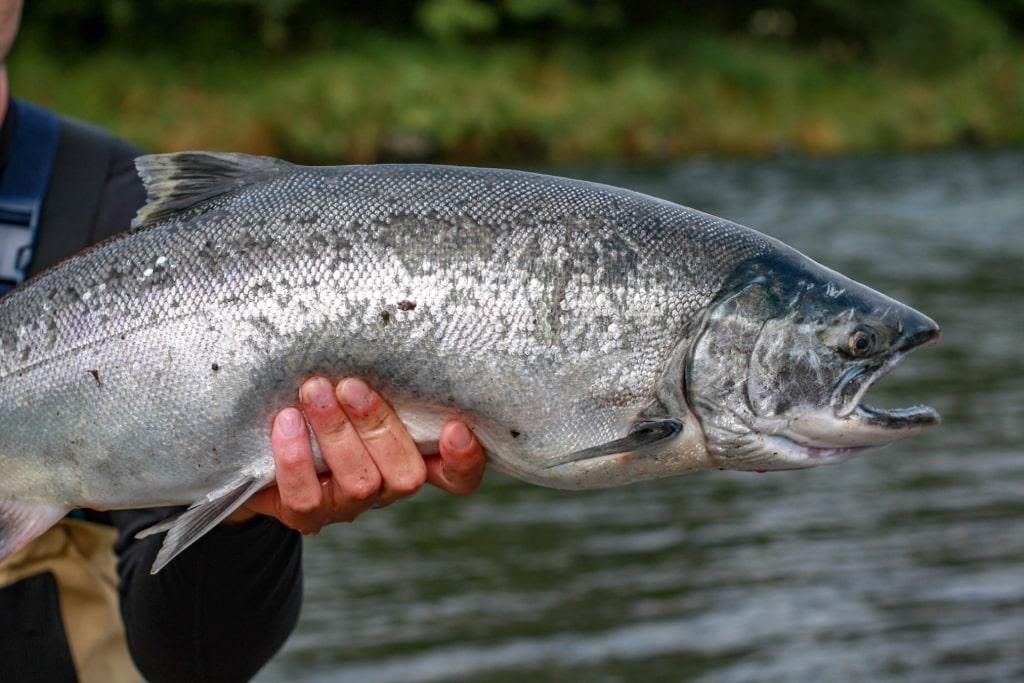
Silver salmon
Most people think the salmon runs are in July, but Alaska has five species of salmon, which run at different times. From late August to September, it’s the turn of the coho, or silver salmon, which has a delicate flavor and is delicious baked, poached, smoked, or grilled.
You could see the salmon run in rivers around Juneau and Sitka, as well as Talkeetna and the Kenai River. And where there are salmon, there’s always a good chance that there will be bears.
The Alaska State Fair
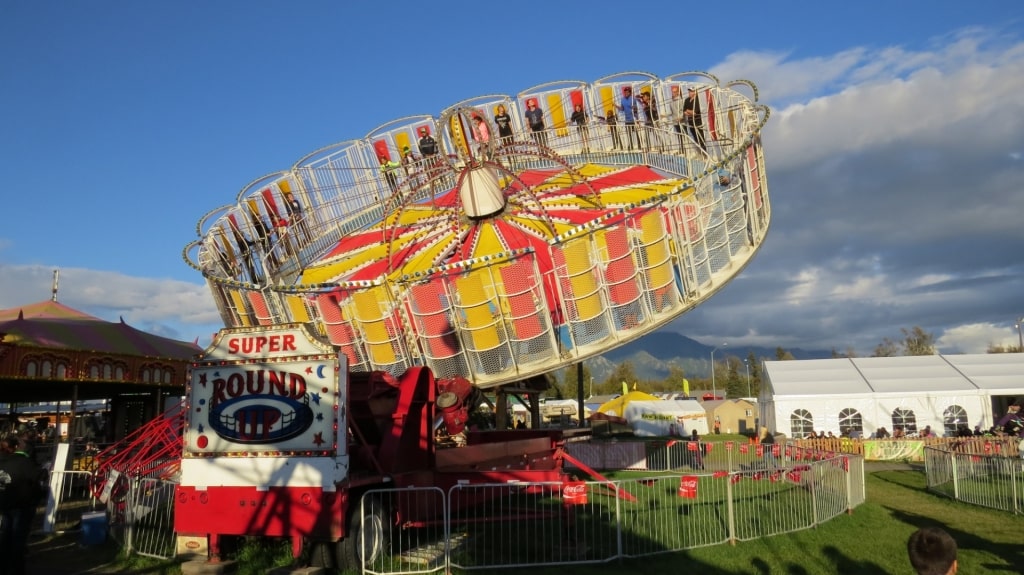
Alaska State Fair Photo by Luke Jones on Flickr, licensed under CC BY 2.0
Should your travels take you to Anchorage, consider stopping by the Alaska State Fair. It takes place in Palmer, some 40 minutes’ drive north of the city, over 14 days and three weekends from the end of August to the first week of September.
You’ll find big-name bands, local food producers, lumberjack and raptor displays, cook-offs, “biggest vegetable” contests, and beer tents, as well as rides and games.
The fair has been going since 1936 and is a major feature on the calendar for locals.
Spectacular Moose Antlers
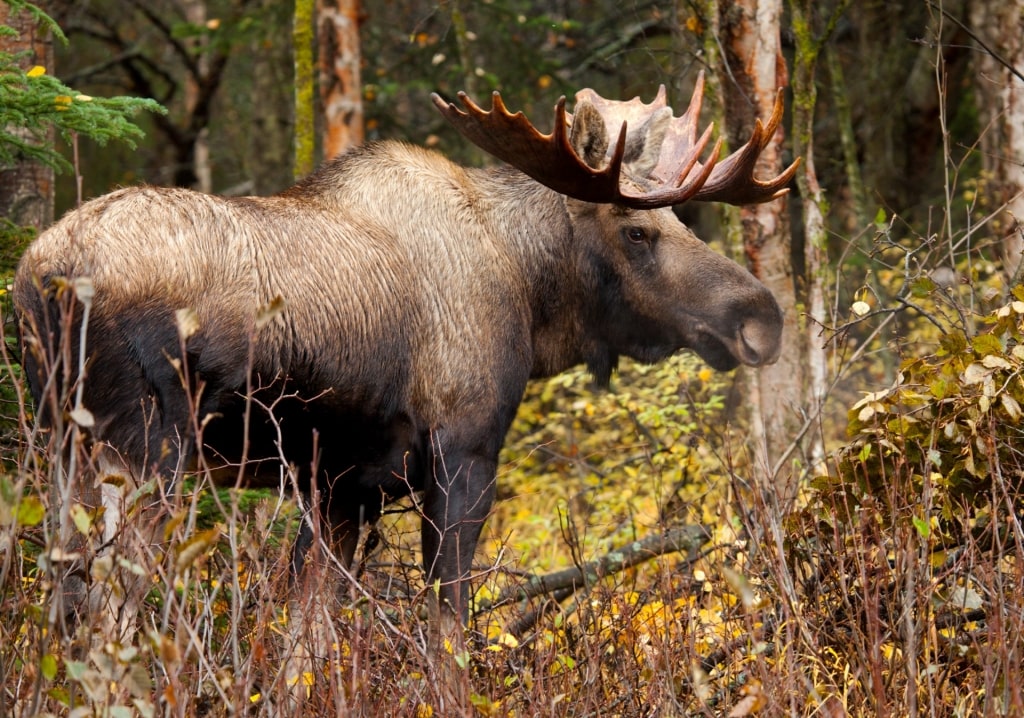
Moose
Visit Alaska in September and you could spot male moose—bulls—at their most spectacular. These impressive beasts, the largest of the deer family, grow to up to seven feet tall at the shoulder and can weigh more than 1,000 pounds.
Moose feed all summer in Alaska, building strength for the fall rutting season, and the increased daylight sets off a chemical reaction that causes their antlers to grow at an astonishing rate, peaking in September.
The bigger the antlers, in the moose world, the more impressive the male. Watching males clashing antlers, in a display of dominance, is quite a sight.
So keep a lookout for these noble creatures; you could spot them in forests, meadows, and on stony Alaskan beaches anywhere along the Inside Passage, displaying their finery.
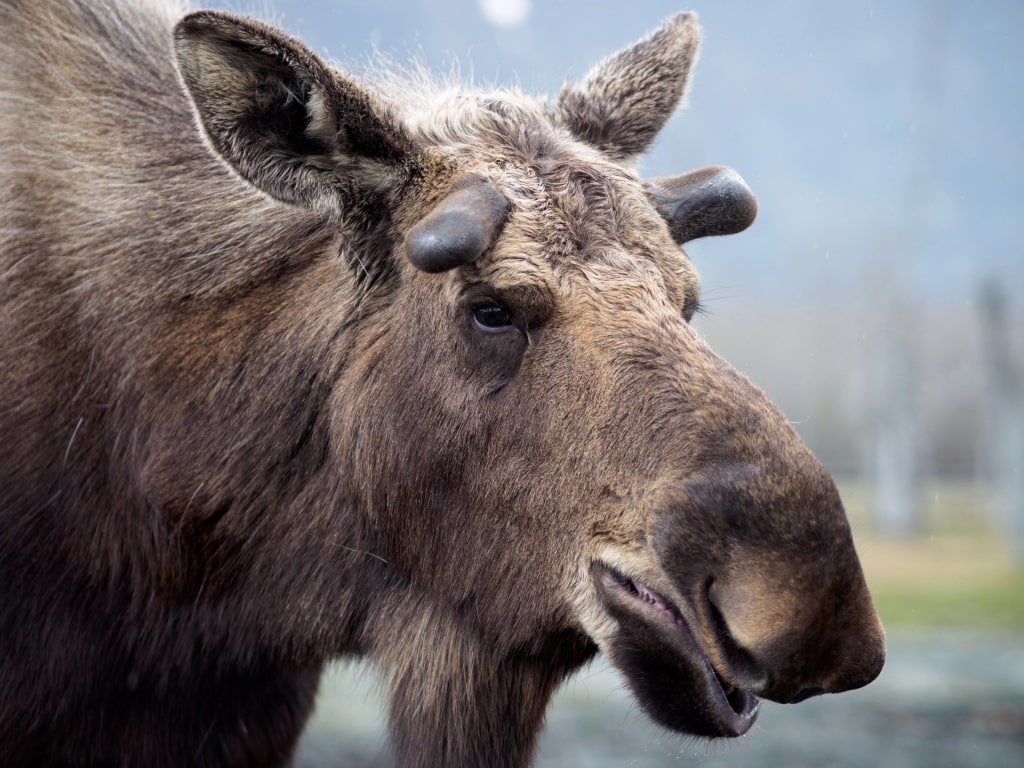
Moose
Once the mating season is over, a bull moose has no further need for his heavy antlers and needs to conserve strength for the winter. So as the snow falls, moose will cast their antlers, starting to grow a new set when spring comes.
Ripe Blueberries
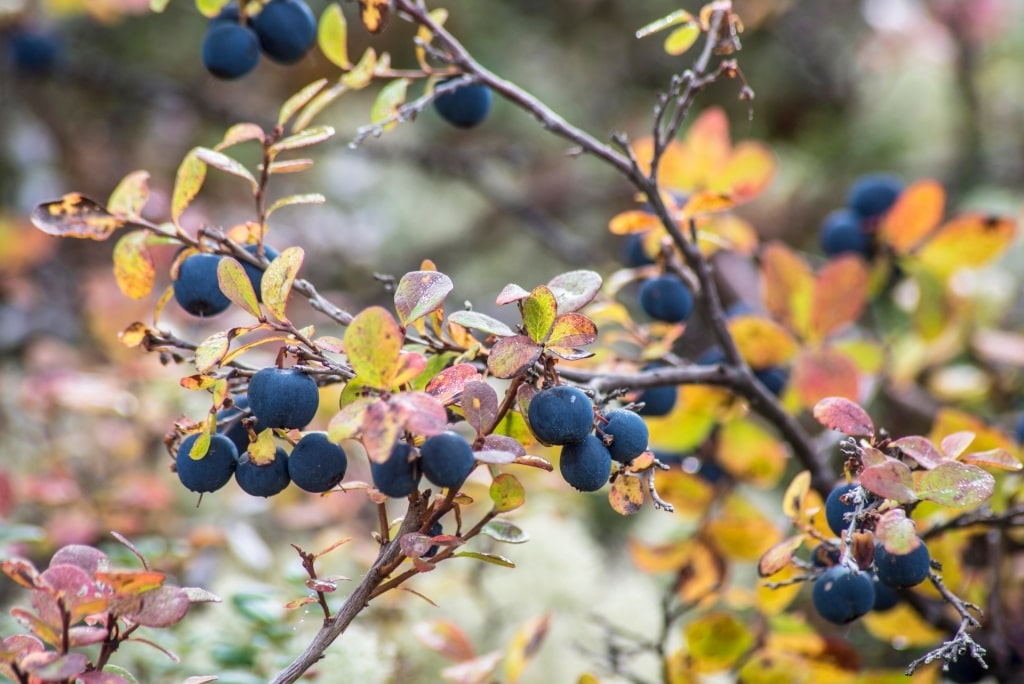
Blueberries
More than 50 types of berries grow in Alaska. September is a great month for foraging wild blueberries, which are packed with nutrients and make a great sweet treat while on a hike.
If you are picking berries while hiking in Alaska, remember that bears enjoy this snack, too; it’s a good idea to carry a bear bell, or make a lot of noise, or best of all, hike with a guide. Also, not all berries are edible, so only pick and eat if you’re absolutely sure what you’re doing.
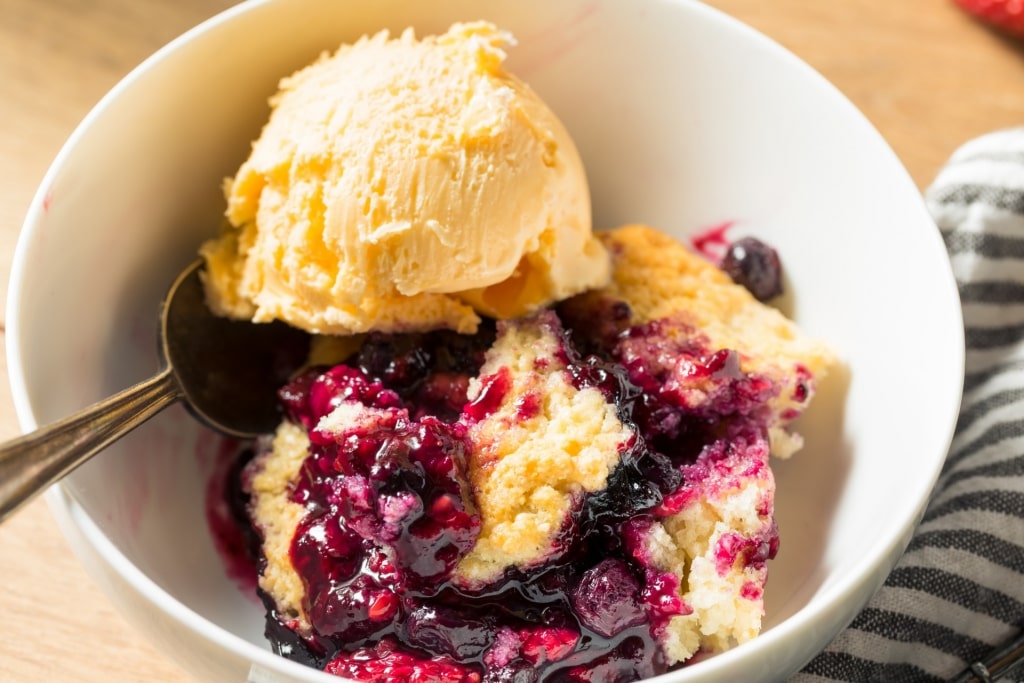
Berry cobbler
If wild foraging isn’t for you, September is the time to try fresh berry cobbler, a specialty served in any restaurant offering local Alaskan food. Berries are stewed and topped with a buttermilk biscuit before being baked in the oven. Served with whipped cream or a scoop of homemade vanilla ice cream, this is an unforgettable Alaskan dessert.
Fantastic Foraging
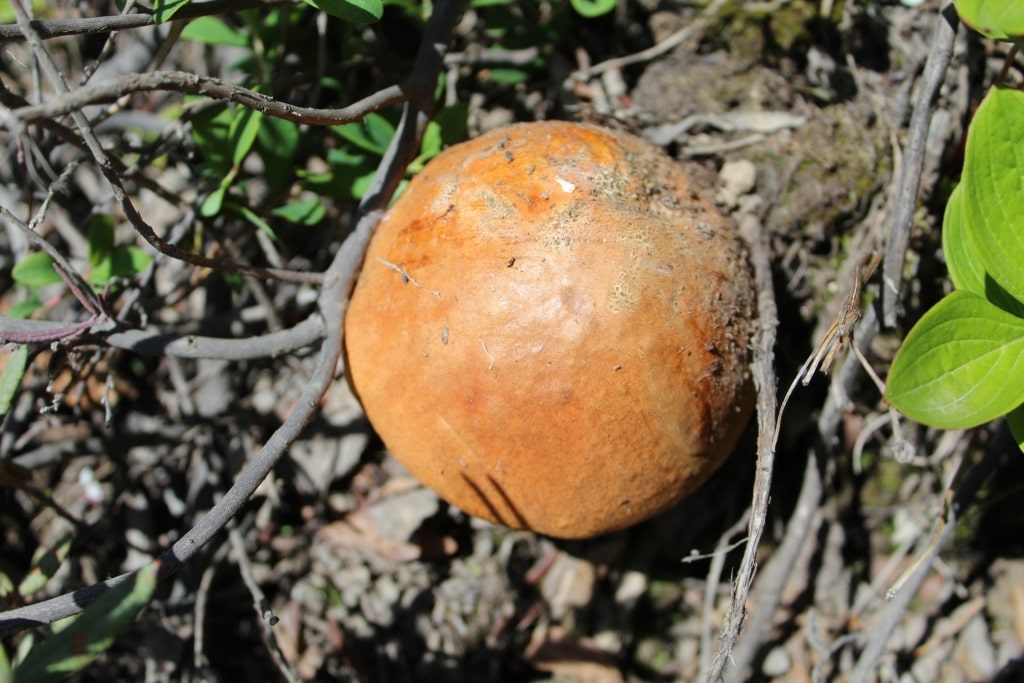
Porcino mushroom
September is mushroom season in Alaska. Locals who know what they’re doing will happily forage for wild mushrooms including porcini and golden chanterelle in the forests.
Of course, you need to be completely confident in your own expertise before picking your own mushrooms, as some are poisonous. But what’s interesting is to go out with a local and learn about the deep connection Alaskans feel to the land.
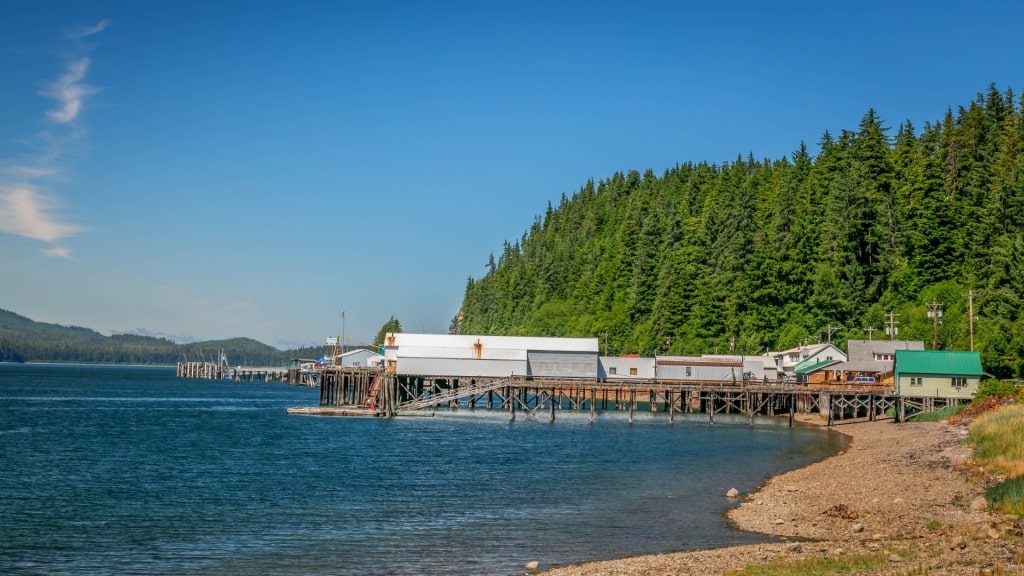
Icy Strait Point
Icy Strait Point, as an example, is owned by the 950-strong Tlingit community. Most of the guides here are Tlingit, and if you join them for a tour, you’ll most likely learn how they forage and fish.
Try a guided hike to the Spasski River Valley, a scenic lookout point where you could see bears fishing in the river below, and the perfect opportunity to learn from your guide about the berries, mushrooms, fern tips, and seafood that are part of the Alaskan diet.
Everything Is Still Open
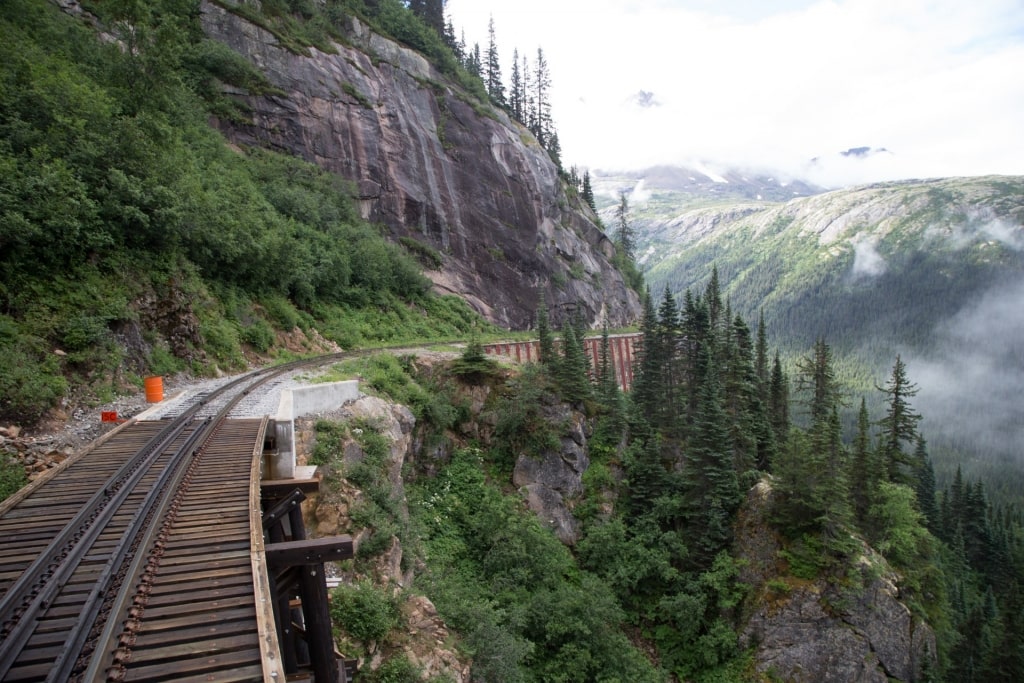
White Pass and Yukon Route Railroad
While it’s tempting to think that Alaska will be winding down for winter in September, this isn’t the case. The season is short here, and tourism is essential to the economy, so businesses will certainly stay open for at least two weeks after Labor Day.
Most all excursions are operating. From Skagway, for example, the White Pass and Yukon Route Railroad runs a full schedule in September, clattering up the White Pass and across the mountains, over spindly bridges and through long tunnels.
The views from up here are magnificent, especially if the first snowfall has dusted the surrounding Alaskan mountains.
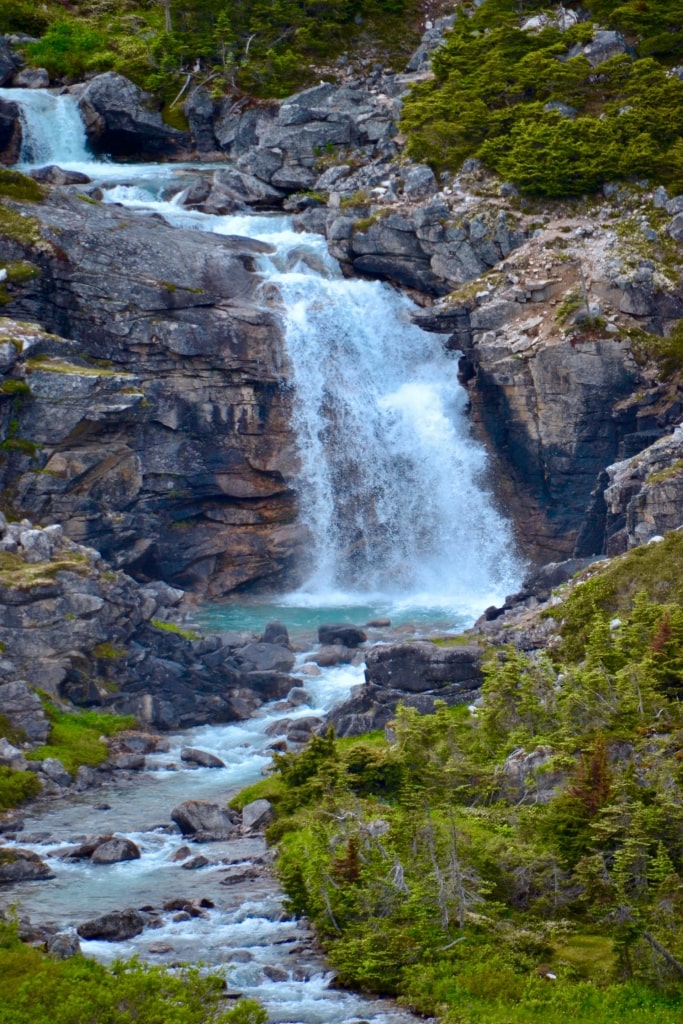
Bridal Veil Falls, Skagway
You’ll see Bridal Veil Falls, one of the best waterfalls in Alaska, hopefully in full flow if there’s been some rain, and a spectacular sight against the flaming colors of the forest.
If you take this excursion, it’s interesting to bear in mind that during the frenzied days of the gold rush in Alaska, at the end of the 19th century, the arrival of fall was no deterrent to the gold prospectors.
This was before the railroad had been built. They would trek over the mountains to the Klondike Gold Fields all winter long, carrying their gear on pack horses and enduring unimaginable conditions of snow, ice, and mud.
The Fish Are Biting
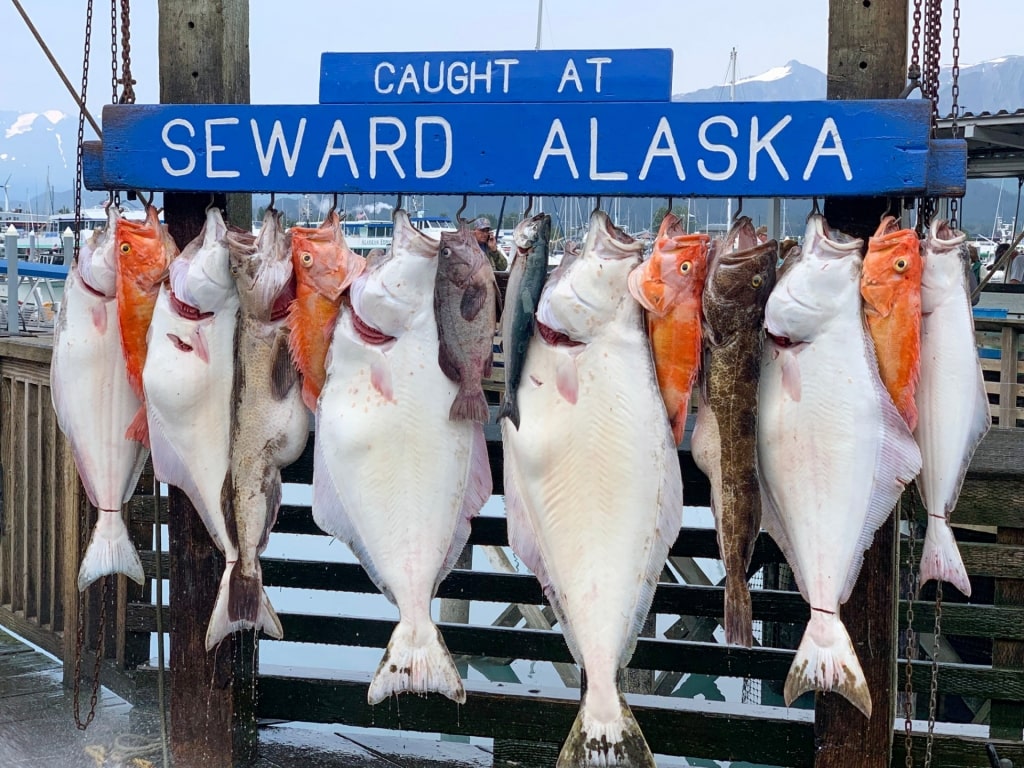
Seward
Fish species vary according to the seasons in Alaska, but September is a great time to catch halibut, whether you’re an enthusiastic angler or a complete beginner. Ketchikan and Juneau are just two spots from which halibut fishing trips operate.
Your captain will have a good idea of where the fish will be, and you’ll be provided with all equipment. The thrill of fishing in Alaska aside, these trips are a great way to spot whales and dolphins and to admire the jagged mountain peaks all around you.
If you’re successful in your mission, your catch will be professionally prepared for you and shipped home as a memory of your time in Alaska in September.
No More Mosquitos
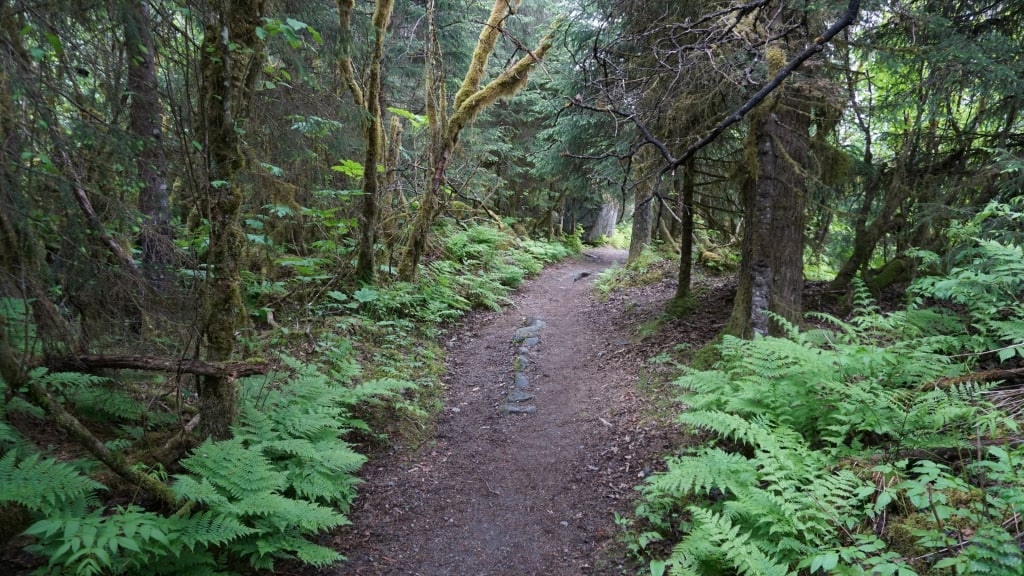
Tongass Forest
Bugs are certainly a presence in Alaska, as they are anywhere with so much humidity and light; the Tongass Forest is officially classified as a temperate rainforest. But the good news is, by September, all the mosquitos have died off, so you won’t be troubled by them.
This isn’t to say that the peak summer months are especially problematic when it comes to mosquitoes, but you will need to use insect repellent then. In September, you won’t need it.
Is September a good time for a cruise to Alaska?
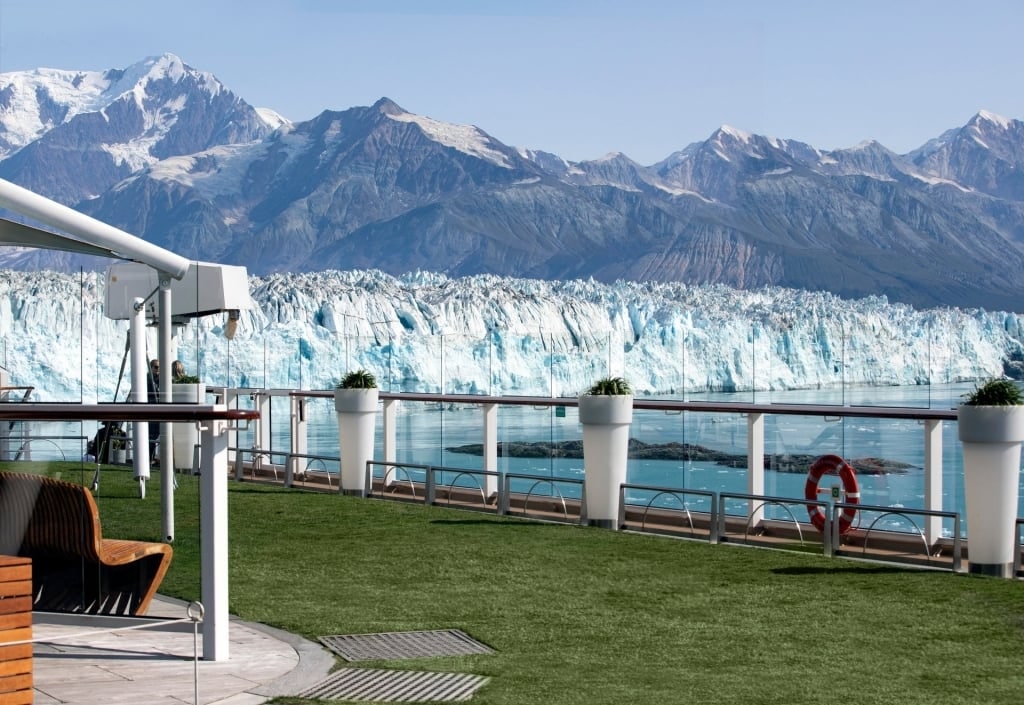
Celebrity Eclipse
Yes! As locals will tell you, Alaska in September is highly underrated. For starters, you can expect far fewer crowds at popular towns like Juneau and Ketchikan.
Between June and August, however, when two million visitors descend—more than twice the entire state’s population—you’ll need to plan ahead to arrange the activities you want. By visiting during this shoulder season month, you’ll get to enjoy the Last Frontier at your own pace.
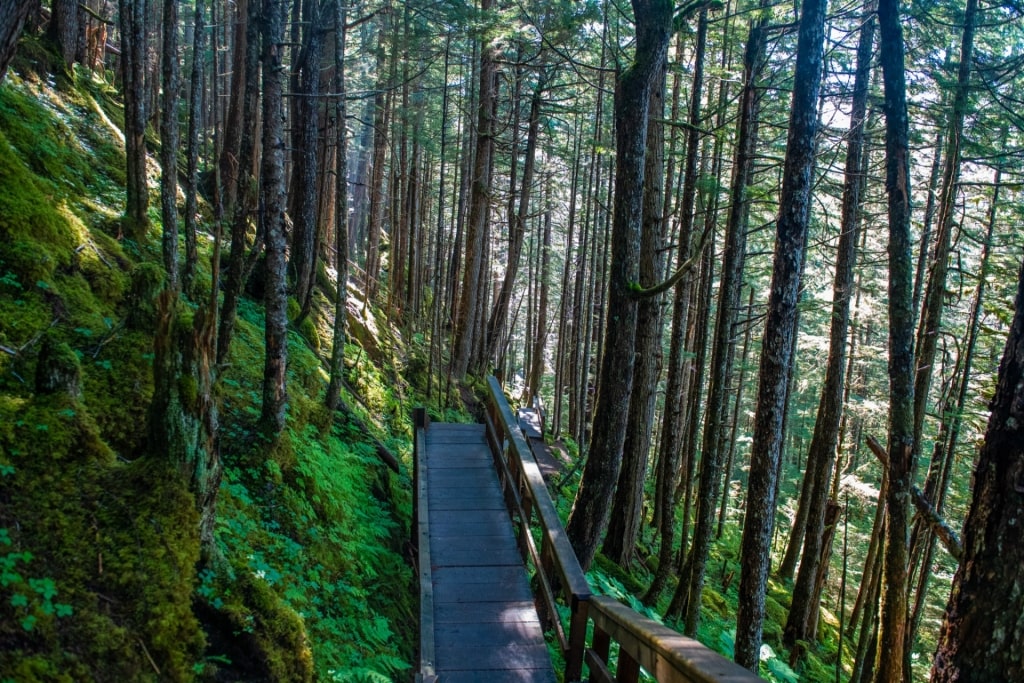
Hiking in Alaska
As an even bigger perk, during September in Alaska, you’ll avoid mosquitos almost entirely. Alaska has a remarkable diversity of wildlife, which extends to the insect kingdom.
During the height of the summer season, all travelers are advised to protect themselves with permethrin-treated clothing and insect repellent. By the end of July, however, the mosquitos are more or less gone. The black flies dissipate by the end of August, allowing travelers to enjoy blissfully bug-free hikes through the woods.
What are some of the best things to do in September?
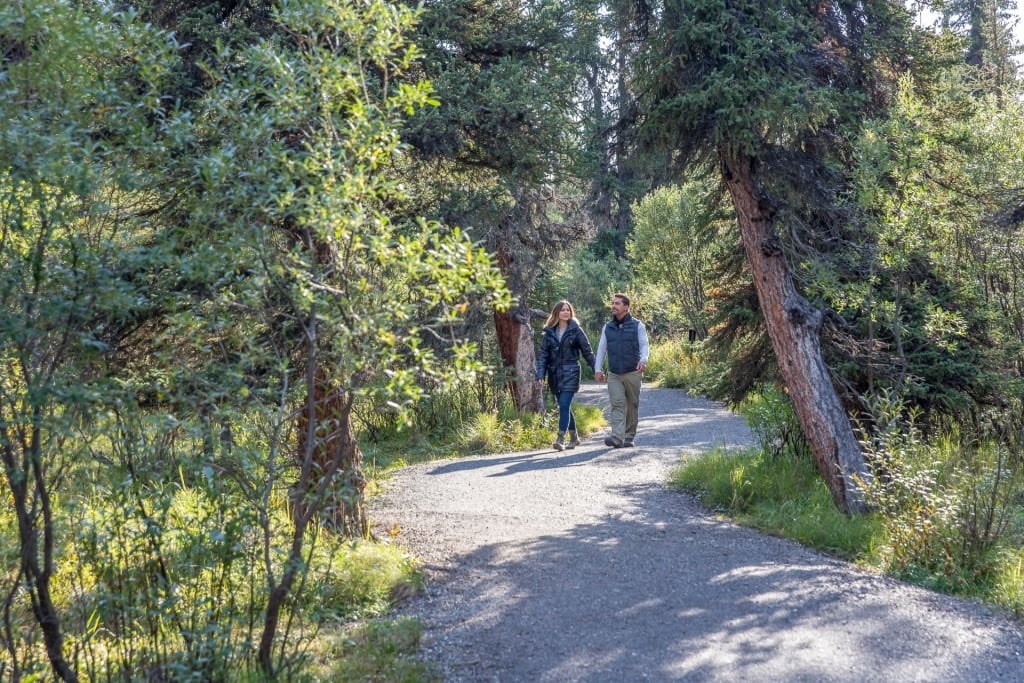
Denali National Park
Whether you visit during summer or early fall in Alaska, there’s an incredible array of activities to try. Active travelers can lean into hiking and mountain biking, both of which are ideal for slightly cooler fall afternoons. Girdwood and Denali National Park are particularly lovely areas for trekking, although they’re hardly the only ones.
For adrenaline junkies, the ZipRider at Icy Strait Point offers heart-stopping thrills, not to mention breathtaking glimpses of the fall colors. You’ll be able to take in all the scenery at 60 miles per hour.
If you prefer to take in the sights at a more leisurely pace, you might prefer the Goldbelt Mount Roberts Tramway in Juneau. This steep vertical tram offers panoramic views for the entirety of the ride.
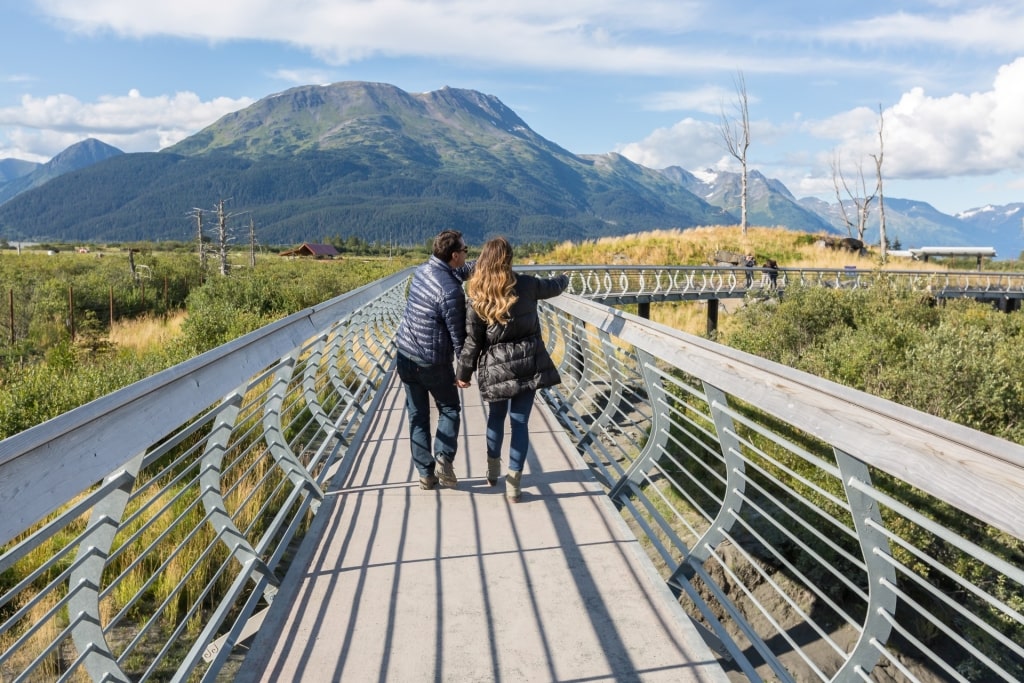
Alaska Wildlife Conservation Center
Get a closer look at brown bears, wolves, and other Alaskan megafauna at the Alaska Wildlife Conservation Center outside of Anchorage.
Or if you’re more excited about marine life, check out sea creatures including the giant Pacific octopus at the Alaska SeaLife Center in Seward. Both places have a strong focus on conservation and education. Most of the animals were found injured, or are otherwise unable to make it in the wild.
If you like your critters more on the cuddly side, you could embark on a short dog sledding adventure in Alaska, just outside of Seward. In Alaska, sled dogs are more than a novelty; they’re still used by park rangers in winter to navigate areas where even the toughest trucks can never go. These intelligent, sociable canines are always a popular hit with kids.
Regardless of the season, it’s always a good idea to have a few rainy day activities in mind when traveling in Alaska, just in case. Luckily, there are plenty from which to choose.
Alaska has world-class museums, for example. Standouts include the Alaska Museum of Science & Nature in Anchorage to the Sealaska Heritage, a cutting-edge space for contemporary Indigenous art.
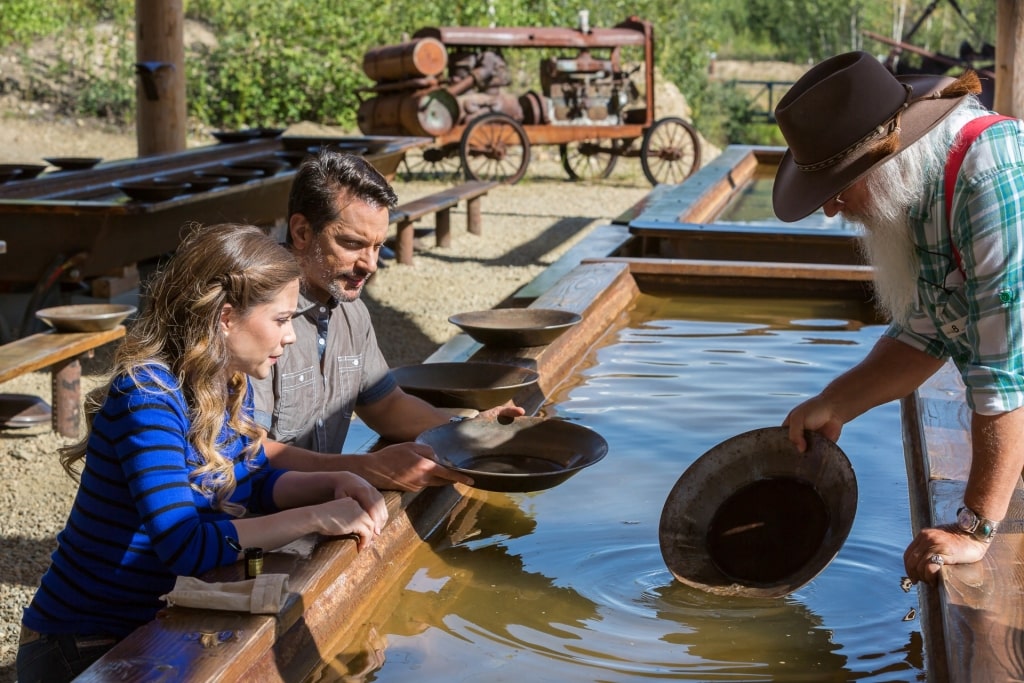
Gold Rush Dredge 8, Fairbanks
Meanwhile up north in Fairbanks, visitors can learn all about the Klondike gold rush at Gold Rush Dredge 8. Although parts of the tour of this former gold field are outdoors, the vast majority of it could be fully enjoyed in the midst of a downpour.
Alaska also has a small but vibrant local arts scene. Small galleries featuring works of Alaskan artists are peppered all over Homer, Seward, Anchorage, Juneau, and more.
What is September weather like in Alaska?
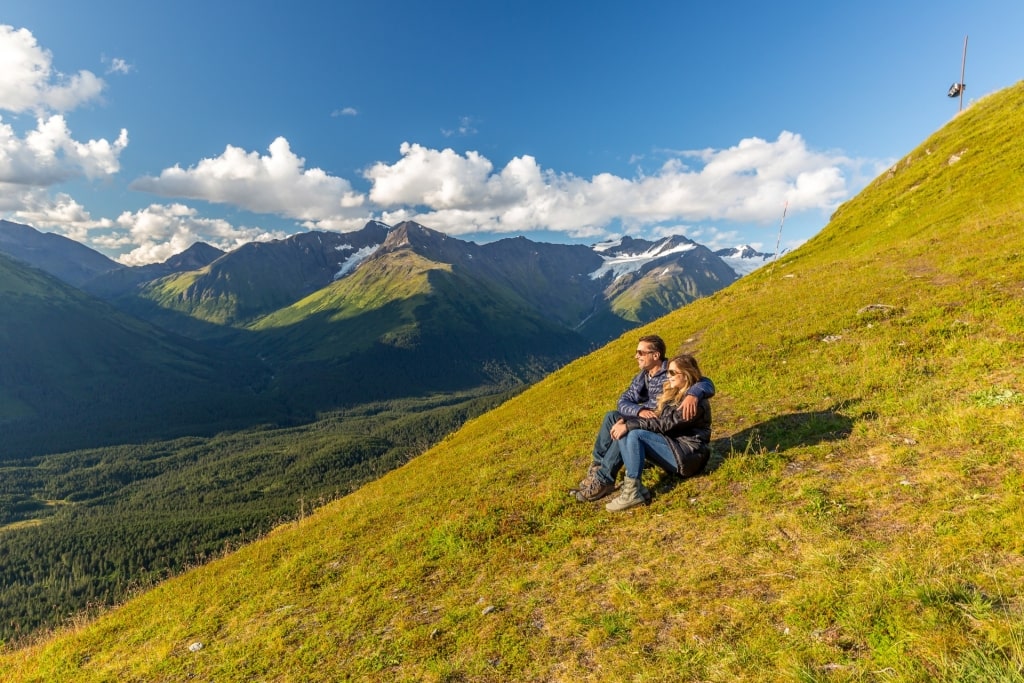
Alyeska
Another benefit of visiting Alaska in September is that the weather tends to be pleasantly mild, albeit on the cooler side. Expect temperatures ranging from the upper 50s°F and 60s°F, with occasional warm, sunny days in the 70s°F towards the beginning of the month.
Over the course of the month, as the daylight wanes, the temperature drops to the 40s°F and 50s°F. Still, weather in September never approaches the icy cold of an Alaskan winter.
As with any season in Alaska, travelers should be prepared for a wide range of weather conditions. On the whole though, September is in the Goldilocks zone for hiking—not too hot and not too cold. Just remember to pack appropriately.
One particularly interesting weather phenomenon during Alaskan September is known by locals as “termination dust.” While the name might sound rather ominous, it’s really just a poetic way to describe the light snowfall that accumulates on mountaintops around the end of summer. The sight of snow-dusted peaks rising majestically over fall foliage is truly something to see.
Can I see the Northern Lights in September?
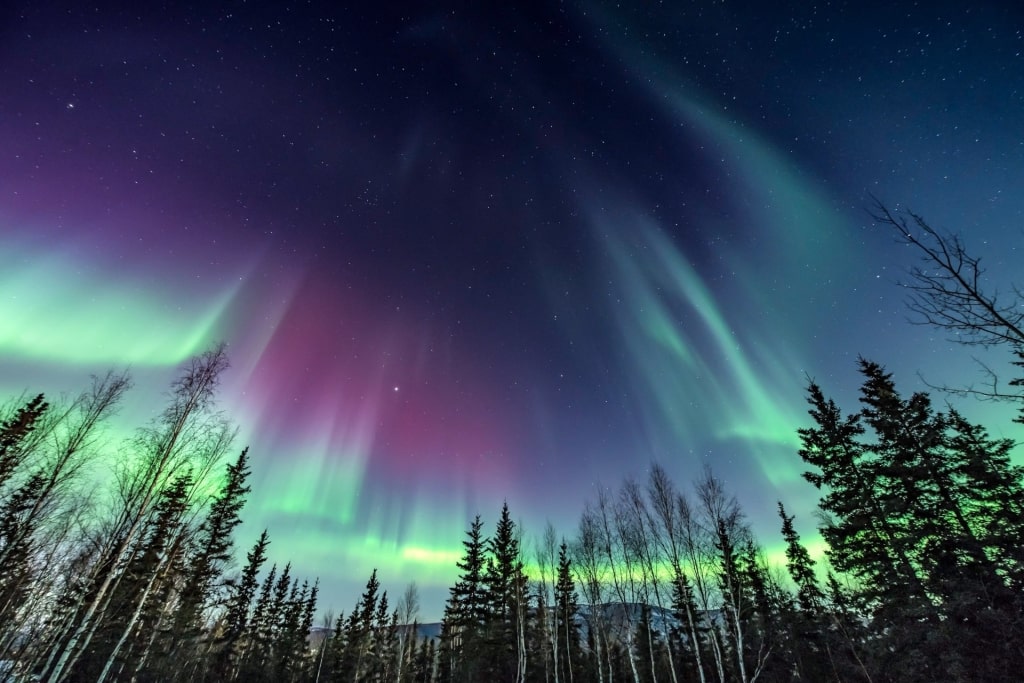
Northern Lights
September is widely considered an ideal time to see the Northern Lights in Alaska. This dazzling light display is brightest in the fall and winter. Since much of Alaska shuts down in the winter—and plenty of locals flee to warmer climes—September is by far the better option. It helps that the nights are darker and generally clearer.
While you don’t need to go to a specific part of Alaska to see the aurora borealis, Fairbanks is an especially popular choice. From September through April, the aurora borealis is a relatively regular occurrence.
What wildlife can I see in September?
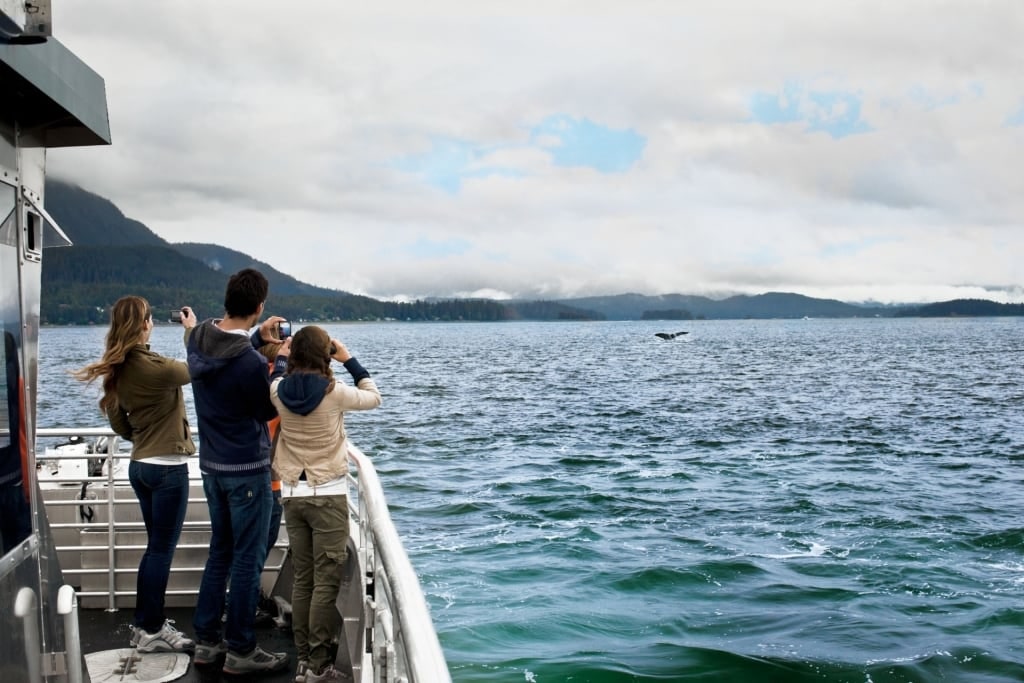
Whale watching in Alaska
September is a great time to see whales of all kinds in September. Dall’s porpoises love to play around boats. Humpbacks can also be spotted this time of year before they migrate towards Hawaii’s warmer waters for the winter. Other species of whales including belugas, bowheads, and gray whales are occasionally spotted as well.
Pods of orcas frequent these waters year-round and can often be seen hunting off the coast. Alaska is host to both transient and resident orcas. The former feed on marine mammals and roam for thousands of miles, while the latter are on a fish-only diet and tend to call one area home.
While on a whale-watching cruise, be sure to keep an eye out for other marine species. Sea otters, which nearly went extinct in the 20th century, thrive in abundant numbers here. These clever mammals can be seen floating in rafts of dozens of otters. Steller sea lions and harbor seals can often be spotted sunning themselves on warm rocks.
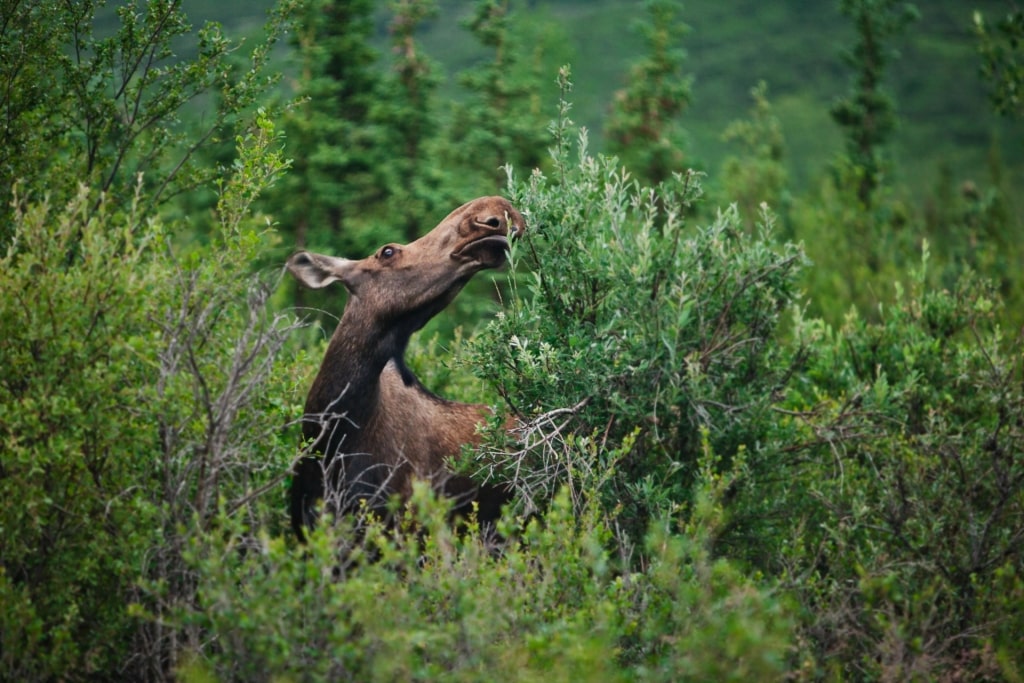
Moose
All of Alaska’s most famous mammals are out and about in September, including moose, elk, Dall sheep, and wood bison. Black, brown, and grizzly bears—the name for inland-dwelling brown bears—are all fattening up for their winter hibernation. Although the biggest salmon run is in June, Alaska’s bears can still be spotted fishing around this time.
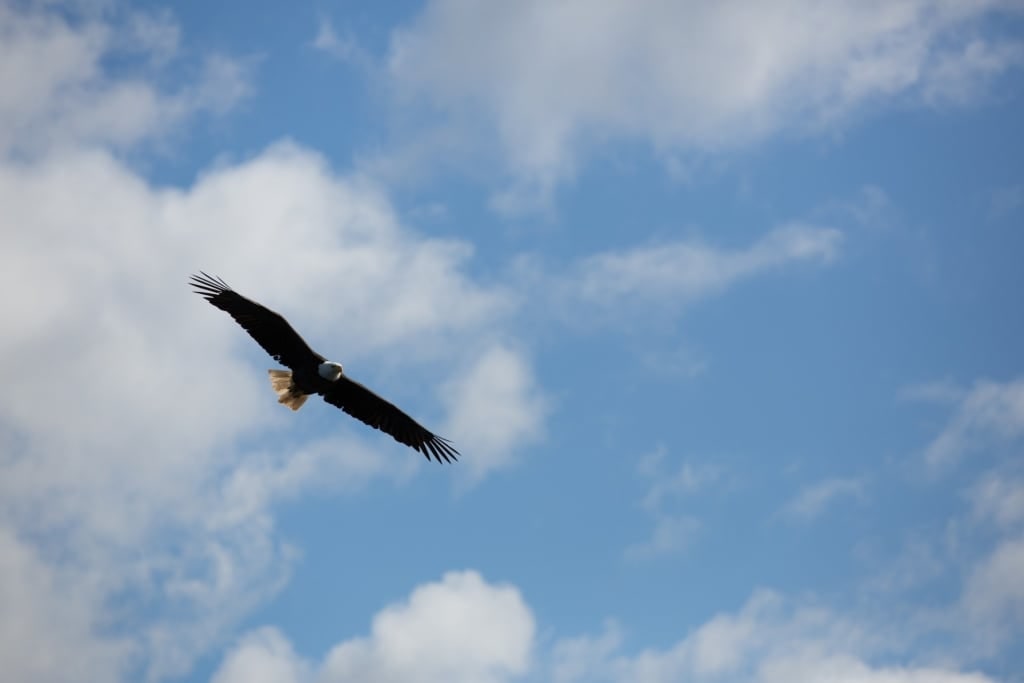
Bald eagle
Finally, Alaska is one of the best places to go bird-watching in the United States. In September, rock ptarmigans, yellow-billed loons, and other species migrate through here.
Circuses of puffins leave for the winter, but are still a common sight in September. Bald eagles are almost as ubiquitous as ravens in many parts of Alaska and can be seen swooping all year long.
Are tourist attractions and services still open?
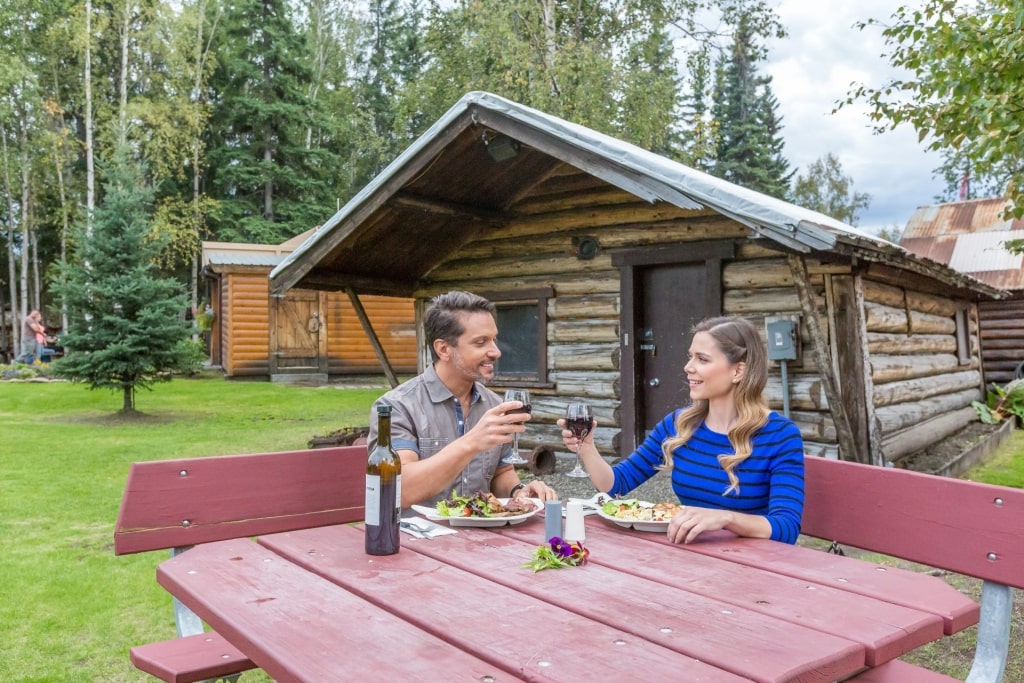
Alaska Salmon Bake, Fairbanks
Not only are most tourist attractions and services still open, but they’re also often cheaper. Most tour operators, gift shops, and many restaurants close for the year in October.
After the summer rush dies down, many offer end-of-season sales and special deals. For this reason, September is often the time locals choose to travel within their own state.
What should I pack for a trip to Alaska in September?
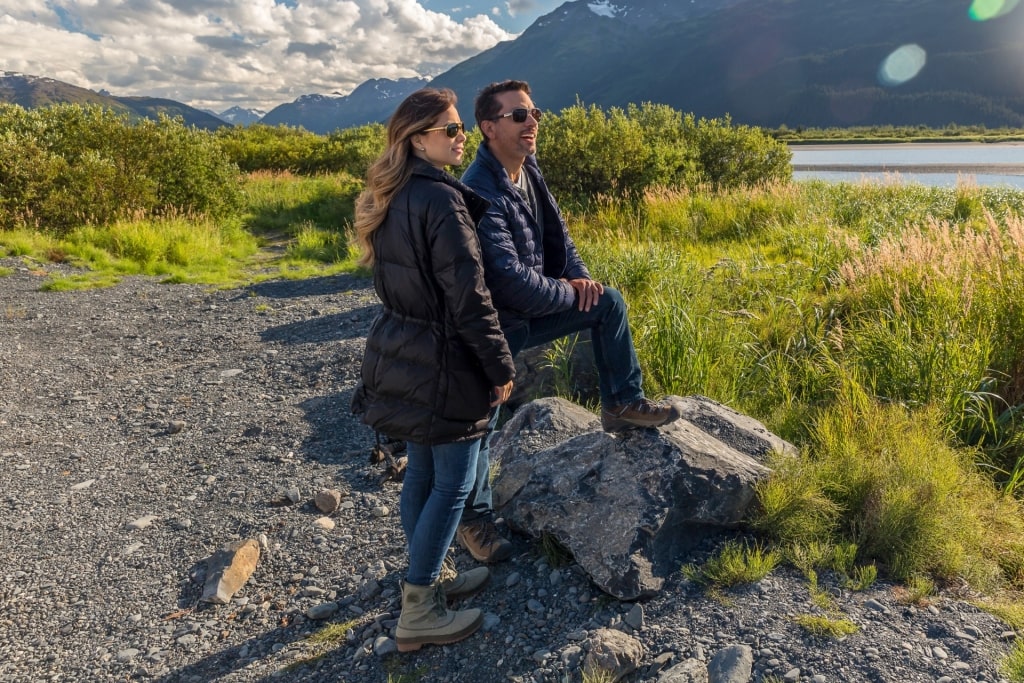
Alaska Wildlife Conservation Center
As with any trip to Alaska, be sure to come prepared for all sorts of different weather conditions and circumstances. No matter what season you come here, the key to success is bringing lots of breathable layers.
If you go whale-watching in Alaska, even on a warm afternoon, temperatures are likely to be on the cool side. As boats approach tidewater glaciers, the temperature drops dramatically in proximity to these massive rivers of ice.
Mountains also tend to make their own weather here. On sunny days, it’s often foggy or even raining at the top of North America’s tallest peak. While smaller peaks are less tricky, it’s worth having light rain gear on hand much of the time.
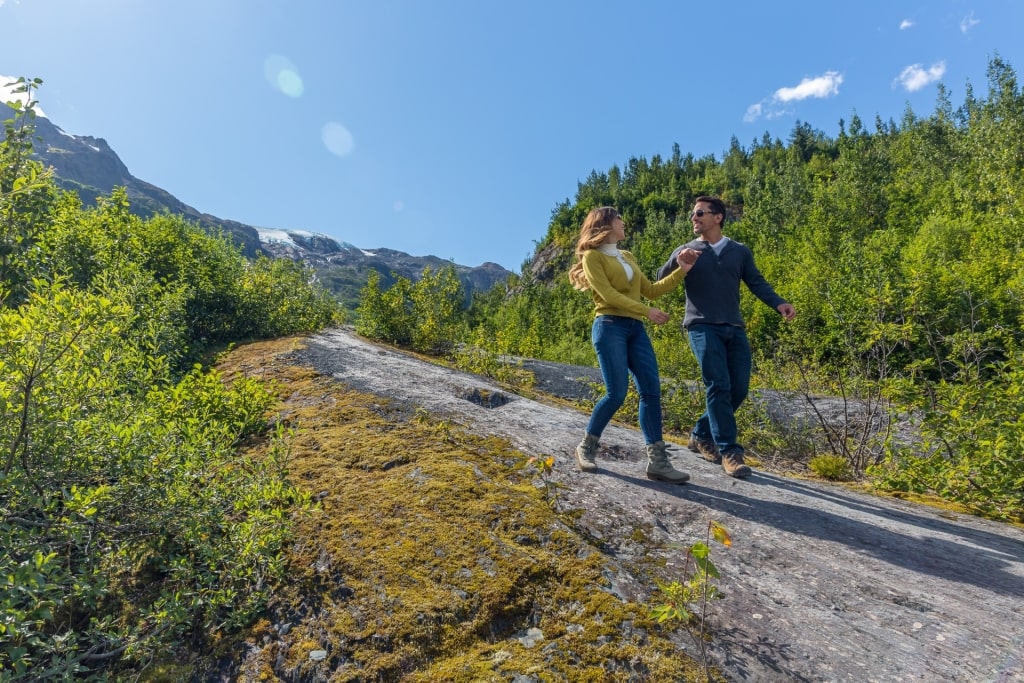
Hiking in Alaska
Especially if you’re planning to go hiking, be sure to bring a portable first-aid kit, sunscreen, and sturdy hiking boots with good traction for scrambling over rocks. Bear spray is highly advised in also areas, as is insect repellent (even though you’re unlikely to encounter many at this time). If you’re planning to fish, note that you’ll need to order your license in advance.
Finally, while smartphone cameras are excellent, this may be the time to invest in a high-quality camera. Mirrorless cameras are significantly more compact and lightweight, making them easier to pack than a standard DSLR. If you can, splurge on a telephoto lens—it’s worth it for capturing absolutely jaw-dropping photos of the wildlife here.
What are the daylight hours like in September?
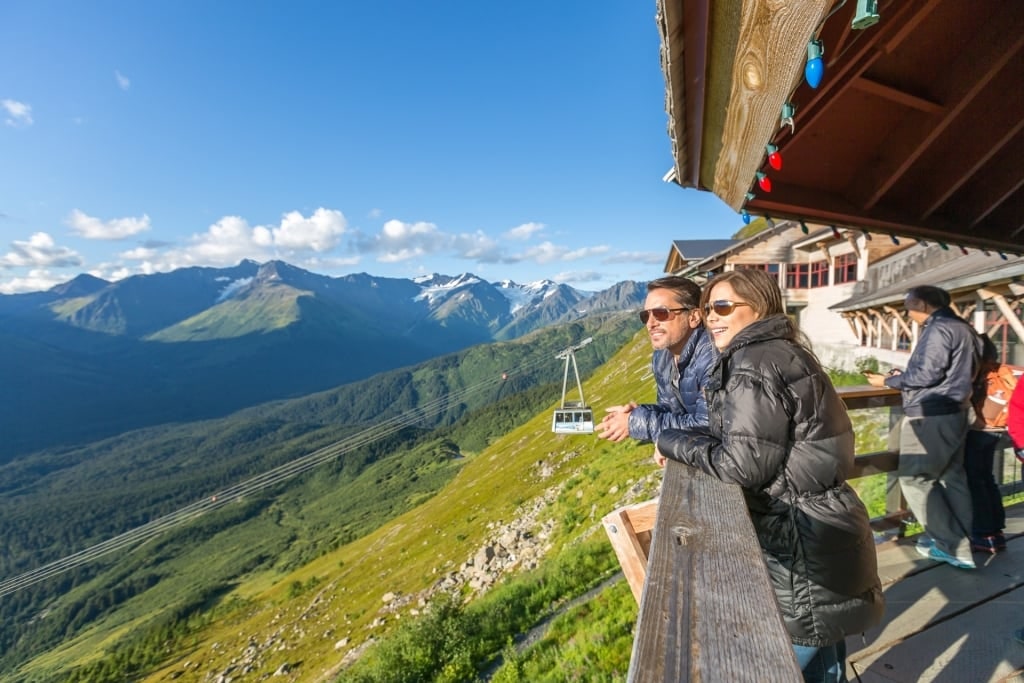
Alyeska
While the sun sets earlier in September, the days in Alaska are still longer than they are in much of the lower 48 around the summer solstice.
Remember that this is the land of the Midnight Sun. The far northern city of Fairbanks sees at least partial 24-hour daylight for a whopping 70 days each year. During peak summer, locals in Alaska have to cover their windows with blackout curtains in order to sleep.
For the first part of September, expect roughly 14 hours of daylight, with sunsets around 9 p.m. As the month goes on, the state becomes noticeably chillier. By the end of the month, the sunset is around 7:30 p.m., meaning there’s still plenty of daylight.
Can I go fishing in September?
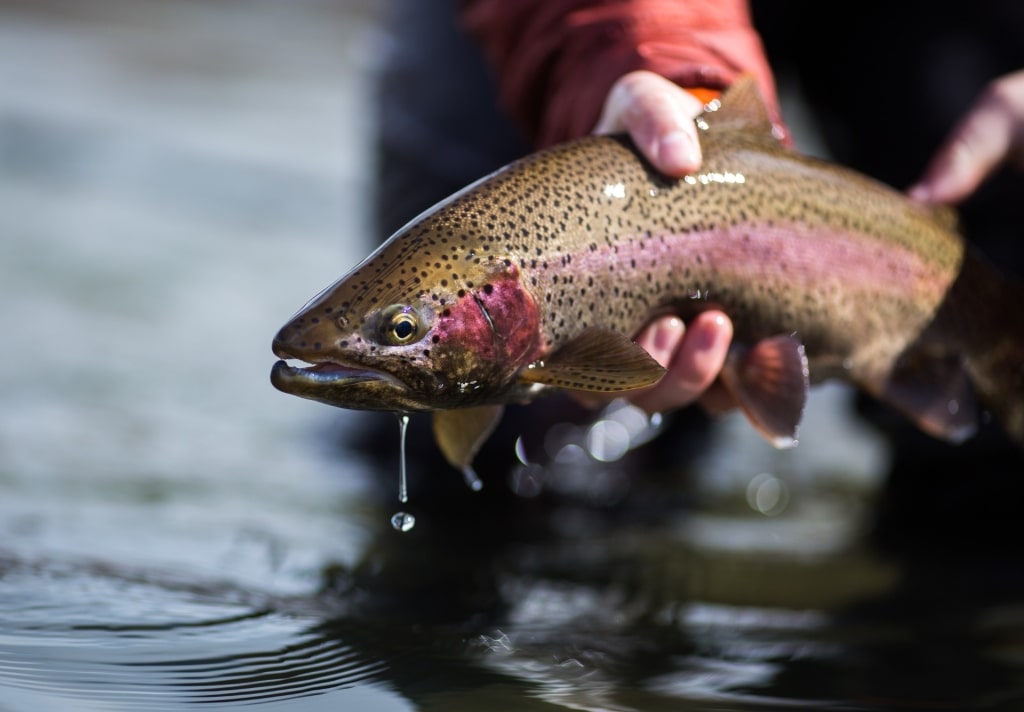
Rainbow trout
September also happens to be one of the best times to go fishing in Alaska. Part of this has to do with the simple fact that there are fewer people fishing, meaning your chances of a catch are better.
September is also the best time to go rainbow trout fishing. With their delicate, pink flesh, these freshwater fish are delicious in all sorts of dishes. They also range in size dramatically—the largest specimen ever caught in Alaska was over 42 pounds.
While July may be the best time to catch sockeye, you can still catch plenty of salmon in September. Both silver and coho salmon are prevalent this time of year. If deep-sea fishing is what you’re after, you may be lucky enough to catch a halibut this time of year.
Most traveling fishermen practice catch-and-release, although it’s worth noting that you do not have to. Certain areas offer the option to filet, smoke, and vacuum pack your catch, meaning you can enjoy it later back home.
What are some unique experiences to have in Alaska in September?

Alaska State Fair Photo by Arctic Warrior on Flickr, licensed under PDM 1.0
Since 1936, Palmer, which is located a 50-minute bus ride from Anchorage, has hosted the Alaska State Fair from late August to early September. Each year, there’s a stacked line-up of live concerts, handicrafts, and exhibitions highlighting Alaskan culture.
What really sets Alaska’s state fair apart from all others, though, is the downright shocking size of its produce. Thanks to the near-unrelenting daylight of the midnight sun, vegetables here can grow to truly enormous proportions. We’re talking 2,000-pound pumpkins and 130-pound cabbages. Kids of all ages will enjoy gawking at the colossal vegetables and taking in the vibes.
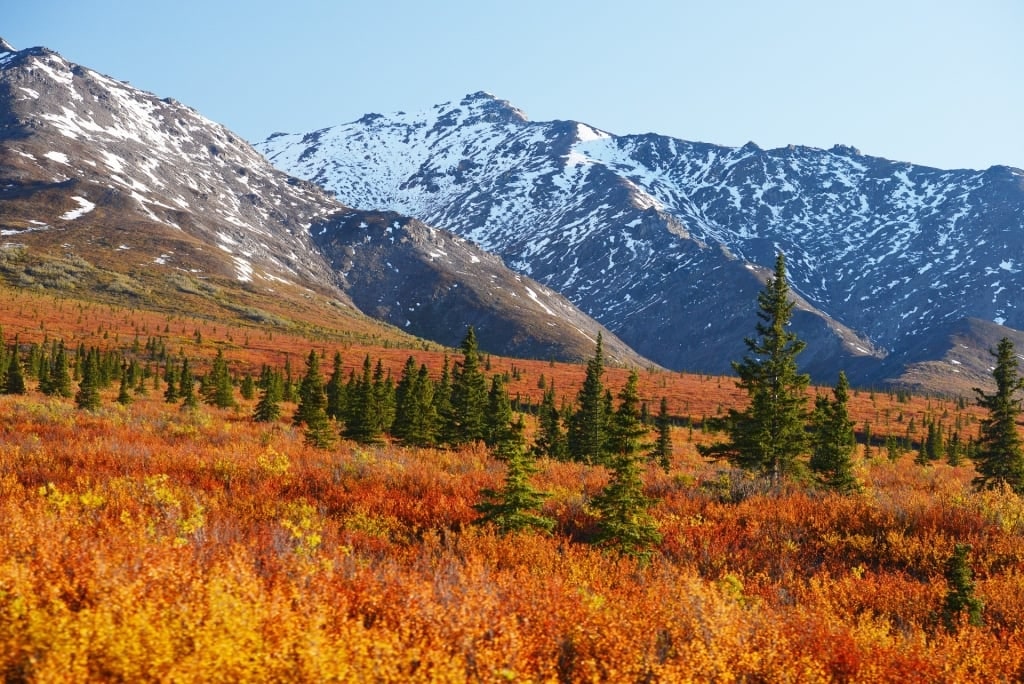
Denali National Park
Alaska is also arguably at its most beautiful at the peak of fall foliage. It’s well worth the trip just to marvel as the Douglas maples, quaking aspens, and Sitka alder change colors. Hiking or taking a funicular through Alaska’s forested areas becomes even more spectacular.
Near downtown Juneau, the Tongass National Forest, the world’s largest temperate rainforest, erupts in all different hues. Denali National Park is particularly famous among amateur photographers during the autumnal months.
If you’re lucky, you might just get a clear shot of the mountain’s snowy peak rising above the fall colors. Girdwood and the surrounding area are equally visually awe-inspiring.
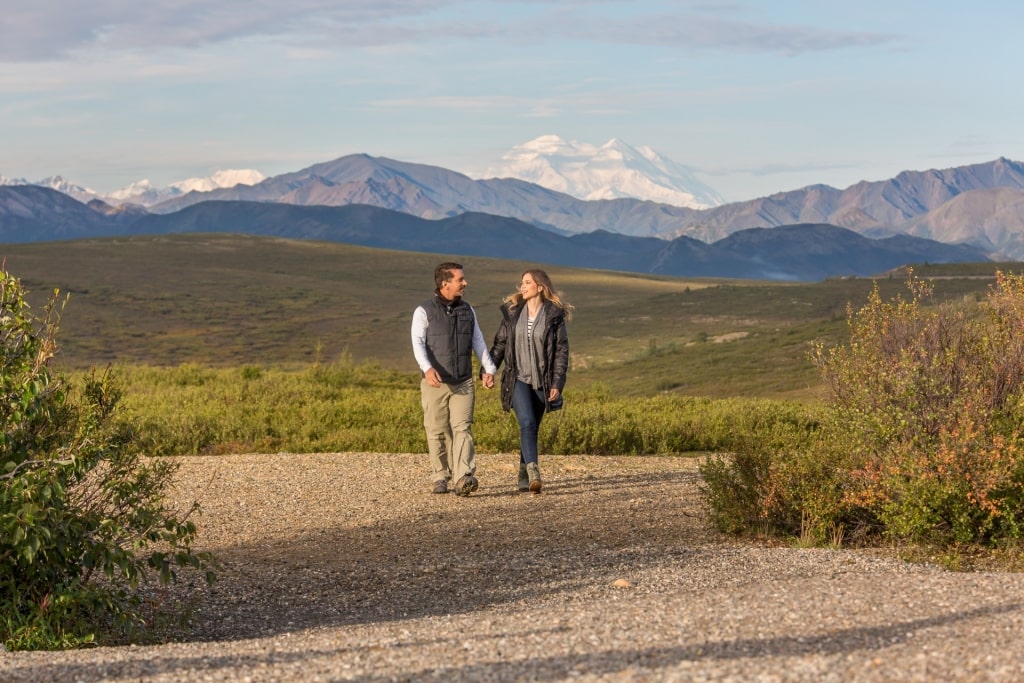
Denali National Park
Are you feeling the call of the wild? Browse our cruises to Alaska in September and plan your fall adventure.
